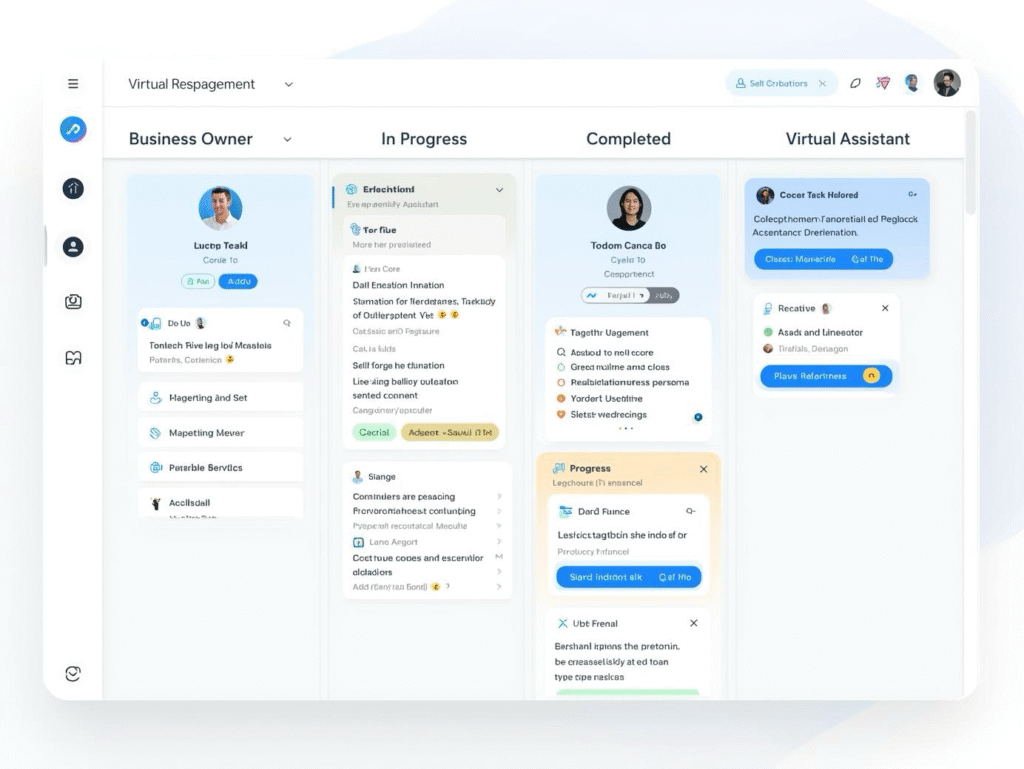Knowing when to hire a virtual assistant can transform your business by freeing up time for high-value work and reducing overwhelm. The right time is typically when administrative tasks consume over 10 hours weekly, you’re missing growth opportunities, or operational bottlenecks are affecting your revenue and work-life balance.
Whether you’re a solopreneur drowning in emails or a growing company struggling to keep up with customer service, recognizing the signs that you need help is the first step toward working smarter, not harder.
In this guide, we’ll walk you through the clear indicators that it’s time to bring on a virtual assistant, what tasks to delegate first, and how to make the transition smooth and successful.
Ready to reclaim your time and focus on growth? Explore our virtual assistant services designed to support your business needs.
What Is a Virtual Assistant and Why Businesses Hire Them
A virtual assistant (VA) is a remote professional who provides administrative, technical, or creative support to businesses and entrepreneurs. Unlike traditional employees, VAs work remotely and can be hired on flexible terms, from part-time to full-time arrangements.
VAs handle a wide range of responsibilities that keep businesses running smoothly without the overhead costs of in-house staff.

Core Responsibilities Virtual Assistants Handle
Virtual assistants take on tasks that consume valuable time but don’t necessarily require your direct attention. Common responsibilities include managing emails, scheduling appointments, data entry, customer service, social media management, and bookkeeping.
Many VAs also specialize in specific areas like graphic design, content writing, or project coordination. This specialization allows business owners to find support that matches their exact needs without hiring multiple full-time employees.
By delegating routine tasks, you create space to focus on strategic decisions that directly impact revenue and growth. A skilled VA becomes an extension of your team, understanding your business operations and working independently with minimal supervision.
How Virtual Assistants Differ From Traditional Employees
The main difference lies in the working arrangement and cost structure. Traditional employees work from your office, require workspace, equipment, and often come with benefits like health insurance and paid time off.
Virtual assistants work remotely using their own equipment and handle their own taxes as independent contractors. This setup eliminates overhead costs and provides flexibility to scale support up or down based on your current needs.
You also gain access to a global talent pool rather than being limited to local candidates. This means you can find specialized skills that might not be available in your immediate area, often at more competitive rates.
Learn more about the specific tasks VAs can handle in our guide on what a virtual administrative assistant does.
Clear Signs You Need to Hire a Virtual Assistant
Recognizing when you need help is half the battle. Certain patterns in your daily work routine signal that bringing on a VA would significantly improve your productivity and business outcomes.
You’re Spending More Time on Admin Than Revenue-Generating Work
If you find yourself answering emails, scheduling meetings, or organizing files for more than 10 hours each week, you’re losing valuable time that could be spent on sales, strategy, or client relationships.
Track your time for one week and categorize each task as either “revenue-generating” or “administrative.” If administrative tasks make up more than 30% of your working hours, that’s a clear sign you need support.
Many business owners fall into the trap of handling everything themselves because they think it’s faster or cheaper. However, your hourly value as a business owner far exceeds what you’d pay a virtual assistant, making delegation a smart financial decision.

You’re Missing Deadlines or Growth Opportunities
When administrative tasks pile up, important opportunities slip through the cracks. You might miss follow-up emails with potential clients, delay project deliverables, or skip networking events because you’re too busy catching up on paperwork.
These missed opportunities have a real cost. A delayed proposal could mean lost revenue. A forgotten follow-up could mean a competitor wins the client. Consistent deadline struggles signal that your current workload exceeds your capacity.
A virtual assistant can manage your calendar, set reminders, handle follow-ups, and ensure nothing falls through the cracks while you focus on closing deals and building relationships.
Your Work-Life Balance Is Suffering
Working nights and weekends just to keep up with daily tasks is not sustainable. If you’re regularly sacrificing personal time, missing family events, or feeling burned out, it’s time to delegate.
Business success shouldn’t come at the expense of your health and relationships. A VA can help you reclaim evenings and weekends by handling routine tasks during standard business hours.
You’ll notice improved focus, better decision-making, and increased energy when you’re not constantly overwhelmed by the volume of work on your plate.
You’re Ready to Scale But Can’t Handle Increased Volume
Growth creates new challenges. More clients mean more emails, more invoicing, more scheduling, and more customer service requests. If you’re turning down opportunities because you can’t handle the workload, you’re limiting your business potential.
Hiring a virtual assistant before you hit maximum capacity allows for smooth scaling. Your VA can handle the increased administrative load while you focus on strategic growth initiatives like marketing, product development, or expanding your service offerings.
This proactive approach prevents the bottlenecks that often occur when businesses try to scale without adequate support systems in place.
When to Hire a Virtual Assistant: Timing and Business Stages
The decision to hire support isn’t just about recognizing problems. It’s also about understanding the right timing based on your business stage and specific circumstances.
Best Timing for Startups and Solopreneurs
For startups and solopreneurs, the ideal time to hire a virtual assistant is when you’re consistently generating revenue and your time is better spent on core business activities than administrative tasks.
A good rule of thumb is to hire when the cost of a VA is less than 20% of your monthly revenue and when administrative work is preventing you from taking on more clients or projects.
Many successful entrepreneurs bring on part-time VA support within their first year of business. This early investment allows them to maintain momentum during critical growth phases rather than getting bogged down in operational details.
Starting with 10-20 hours per week is often sufficient for small businesses and can scale up as needs grow.
Right Time for Growing Companies
For established businesses experiencing growth, hiring a virtual assistant often aligns with expansion milestones like launching new products, entering new markets, or significantly increasing client volume.
If your team is stretched thin and employee productivity is declining because of administrative overload, bringing on VA support can relieve pressure without the long-term commitment of hiring full-time staff.
Growing companies also benefit from VAs during seasonal peaks or special projects that require temporary support. This flexibility allows you to maintain service quality without permanent staffing increases.
Strategic Hiring Before Major Business Transitions
Planning a major transition like a rebrand, system migration, or office relocation? Hiring a VA beforehand can ensure these projects stay on track without disrupting your regular operations.
VAs can coordinate logistics, manage communication, track project milestones, and handle the countless details that accompany major changes. This frees you and your core team to maintain focus on serving existing clients during the transition period.
Wondering which tasks to hand off first? Check out our guide on how to delegate project management for practical delegation strategies.
Tasks to Delegate When You Hire a Virtual Assistant
Not all tasks are created equal when it comes to delegation. Understanding what to delegate helps you maximize the value of your VA relationship from day one.
| Task Category | Examples | Why Delegate |
| Administrative | Email management, calendar scheduling, data entry, file organization | Frees up 10-15 hours weekly for strategic work |
| Customer Service | Responding to inquiries, managing support tickets, follow-up communications | Ensures consistent, timely customer experience |
| Marketing Support | Social media posting, content scheduling, basic graphic design | Maintains consistent online presence without daily effort |
| Financial Tasks | Invoice processing, expense tracking, payment follow-ups | Keeps finances organized and cash flow healthy |

High-Value Tasks to Keep vs. Tasks to Delegate
Keep tasks that require your unique expertise, strategic thinking, or personal relationships. This includes closing major deals, developing business strategy, creating core content, and building key partnerships.
Delegate repetitive, time-consuming tasks that follow clear processes. These include appointment scheduling, email filtering, data entry, travel booking, and routine customer inquiries.
A helpful framework is to ask: “Does this task directly generate revenue or require my specific skills?” If the answer is no, it’s likely a good candidate for delegation.
How to Choose the Right Virtual Assistant for Your Needs
Finding the right VA match requires clarity about your needs and a strategic approach to the hiring process.
Defining Your Requirements and Budget
Start by listing all the tasks you want to delegate, estimating how many hours per week each requires. This gives you a clear picture of whether you need part-time support (10-20 hours weekly) or more extensive help.
Research typical rates for the skills you need. General administrative VAs typically charge $15-30 per hour, while specialized VAs (like those with bookkeeping or design skills) may charge $30-60 per hour.
Set a realistic budget that reflects the value you’ll gain from reclaimed time. If a VA saves you 15 hours weekly at $25/hour ($375/week), but those 15 hours allow you to generate $2,000 in additional revenue, the return on investment is clear.
| Business Stage | Recommended Hours | Typical Budget Range | Best For |
| Startup/Solopreneur | 10-20 hours/week | $600-1,200/month | Email, scheduling, basic admin |
| Growing Business | 20-30 hours/week | $1,200-2,400/month | Customer service, marketing support, bookkeeping |
| Established Company | 30-40 hours/week | $2,400-4,000/month | Project management, team coordination, specialized tasks |
| Multiple VAs | Varies by role | $3,000-8,000+/month | Department-specific support across operations |
Where to Find Qualified Virtual Assistants
You can hire VAs through specialized agencies, freelance platforms, or referrals. Agencies like VA4Growth vet candidates and match you with VAs who fit your specific needs, saving you time in the hiring process.
Freelance platforms offer access to a wide pool of candidates but require more effort to screen and verify qualifications. Referrals from other business owners can be valuable because you get firsthand accounts of work quality and reliability.
Consider the level of support you need during onboarding. Agencies typically provide training resources and backup support, while independent VAs require more direct management from you.
Key Questions to Ask During the Hiring Process
Ask about their experience with tasks similar to yours, their availability and time zone, their communication preferences, and their backup plan if they’re unavailable.
Inquire about the tools and software they’re proficient in, how they handle confidential information, and what their typical turnaround times are for different types of tasks.
Request examples of past work and references from previous clients. A professional VA will have these readily available and be comfortable discussing their work history.
Ready to find the perfect virtual assistant for your business? View our transparent pricing options and get started today.

Making the Transition: Onboarding Your Virtual Assistant
A smooth onboarding process sets the foundation for a productive working relationship and helps your VA become effective quickly.
Creating Clear Processes and Documentation
Before your VA starts, document your most common tasks with step-by-step instructions. Include screenshots, login credentials (through a secure password manager), and examples of completed work.
Create templates for recurring tasks like email responses, social media posts, or client communications. These templates ensure consistency and reduce the time needed for training and revisions.
Organize all training materials in a shared folder or project management tool where your VA can easily reference them. Update documentation as processes evolve or new tasks are added.
Setting Expectations and Communication Guidelines
Establish clear expectations about work hours, response times, and communication methods from day one. Decide whether you’ll communicate primarily through email, messaging apps, or project management platforms.
Schedule regular check-ins, especially during the first month. Weekly video calls help build rapport, address questions, and ensure alignment on priorities and goals.
Clarify how you prefer updates on completed tasks and how you want to be notified about issues or delays. Some business owners prefer daily summaries, while others want updates only when problems arise.
Building Trust Through Gradual Responsibility Increases
Start with lower-risk tasks and gradually increase complexity as your VA demonstrates competence and reliability. This approach builds mutual confidence and allows your VA to learn your preferences without pressure.
Provide constructive feedback regularly, acknowledging what’s working well while addressing areas for improvement. Positive reinforcement encourages your VA and strengthens your working relationship.
As trust develops, empower your VA to make certain decisions independently within defined parameters. This autonomy increases efficiency and allows them to truly function as an extension of your team.
Explore different virtual assistant jobs and specializations to understand which skills best match your needs.
Key Takeaways: Knowing When to Hire a Virtual Assistant
Understanding when to hire a virtual assistant comes down to recognizing the patterns that signal you need help. If you’re spending more time on administrative tasks than revenue-generating activities, missing opportunities due to workload, or sacrificing work-life balance, it’s time to delegate.
The best time to bring on a VA is before you reach maximum capacity. This proactive approach allows smooth scaling and prevents the burnout and missed opportunities that come from trying to do everything yourself.
Start by delegating clearly defined, repetitive tasks and gradually expand responsibilities as your working relationship develops. With the right VA and proper onboarding, you’ll quickly see improvements in productivity, focus, and business growth.
Taking the first step toward delegation might feel challenging, but the return on investment in time, energy, and business results makes it one of the smartest decisions you can make for your company’s future.
Ready to take the next step? Contact us to discuss your specific needs and find the perfect virtual assistant solution for your business.
Frequently Asked Questions: When to Hire a Virtual Assistant
How do I know when it’s the right time to hire a virtual assistant?
The right time is when administrative tasks consume more than 10 hours weekly, you’re missing business opportunities due to workload, or your revenue could increase if you focused on core business activities instead of routine tasks. If the cost of a VA is less than 20% of your monthly revenue and would free you to generate more income, it’s time to hire.
What signs show that my business needs a virtual assistant?
Key signs include regularly working evenings and weekends to keep up, missing deadlines or follow-ups, declining new opportunities because you’re too busy, feeling overwhelmed by email and administrative tasks, and noticing that your business growth has plateaued because you can’t take on more work.
Should I hire a virtual assistant even if my business is small?
Yes, many successful solopreneurs and small business owners hire VAs within their first year. Starting with part-time support (10-20 hours weekly) allows you to maintain growth momentum without getting overwhelmed. Even small businesses benefit from delegating routine tasks that don’t require the owner’s direct involvement.
Is a virtual assistant worth it for busy entrepreneurs?
Absolutely. The return on investment typically far exceeds the cost. If a VA costs $25/hour and saves you 15 hours weekly, that’s $375/week. If those 15 hours allow you to generate even $1,000 in additional revenue, you’re seeing a positive return while also reducing stress and improving work-life balance.
When is the best time to outsource tasks to a virtual assistant?
The best time is before you reach maximum capacity. Waiting until you’re completely overwhelmed makes onboarding and training more difficult. Hire when you’re generating consistent revenue, have identified repetitive tasks that consume your time, and can clearly articulate what you need help with.
What tasks should I delegate first when hiring a virtual assistant?
Start with clearly defined, low-risk tasks like email management, calendar scheduling, data entry, and travel booking. These tasks have established processes and minimal consequences if mistakes occur. As your VA learns your business, gradually add more complex responsibilities like customer service, social media management, or bookkeeping.





